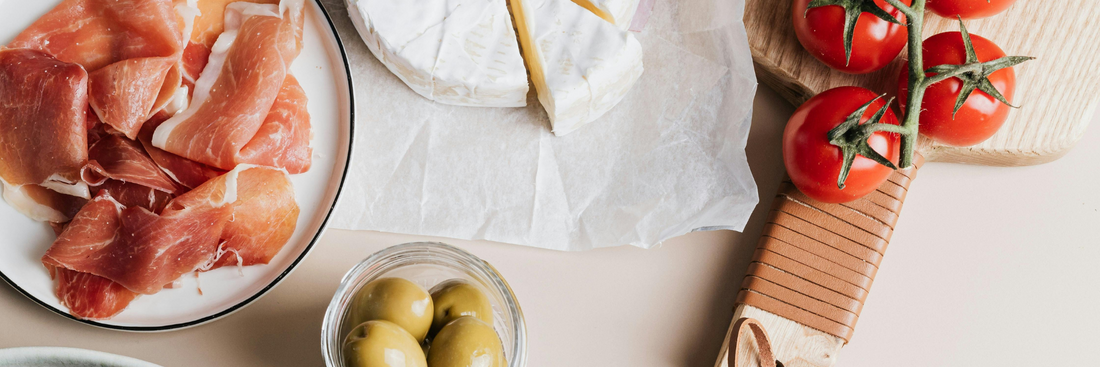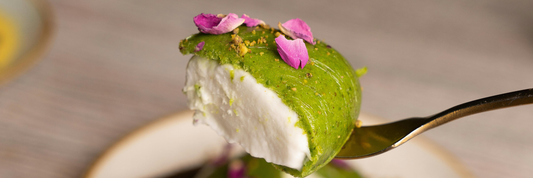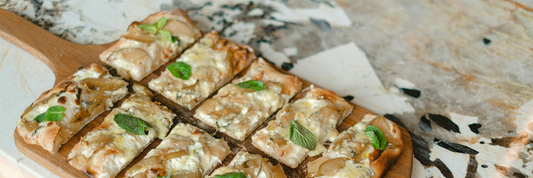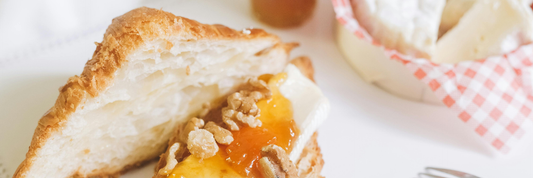When it comes to timeless food pairings, few combinations can rival cheese and olives. Whether you’re running a café, catering company, or restaurant in Canada or the USA, this duo can elevate your menu offerings and appeal to a wide audience. The creamy richness of cheese balanced with the salty, tangy bite of olives creates harmony in both flavor and texture. From casual picnics to elegant catering events, cheese and olives fit perfectly across occasions.
In this guide, we’ll explore why cheese and olives work so well together, the best types of cheeses and olives, how to create a professional cheese and olive board, drinks that pair beautifully with this combo, and how to present everything in eco-friendly packaging that supports both quality and sustainability.
- The Best Cheese for Salads: Flavor, Texture & Nutrition Tips
- How To Pair Cheese and Tea – A Complete Guide
- Cheese and cholesterol: Is it safe and which kinds are best?
Why Cheese and Olives Work So Well Together

The success of cheese and olives as a pairing lies in their contrast and balance. Here’s why this duo continues to win hearts:
Flavor Harmony
- Cheese: Creamy, buttery, or sharp, depending on the variety.
- Olives: Salty, briny, and tangy with a slightly bitter edge.
Together, these flavors create depth without overpowering each other.
Textural Contrast
Cheese can range from soft and spreadable to firm and crumbly. Olives, on the other hand, are smooth, meaty, and sometimes even chewy. Pairing these textures keeps each bite interesting.
Cultural Versatility
Cheese and olives appear across global cuisines:
- Mediterranean mezze plates.
- Spanish tapas boards.
- North American cheese platters.
This makes them adaptable for cafés, restaurants, catering menus, and even takeout snack boxes.
For food businesses, the versatility of cheese and olives ensures you can present them in ways that align with your brand, whether rustic, gourmet, or health-focused.
Types of Olives for Pairing
Olives are not all the same, their flavor varies depending on ripeness, curing method, and region of origin. Knowing your olive varieties helps you build the right pairings.

Green Olives
- Flavor: Bright, tangy, slightly bitter.
- Best With: Creamy cheeses like goat cheese or brie.
- Use Case: Perfect for light cheese boards in cafés or brunch menus.
Black Olives
- Flavor: Milder, with a softer, earthy taste.
- Best With: Aged cheeses such as cheddar or gouda.
- Use Case: Excellent for grab-and-go snack boxes where mild flavors appeal to wider audiences.
Kalamata Olives
- Flavor: Rich, salty, and robust, with a fruity undertone.
- Best With: Bold cheeses like manchego or pecorino.
- Use Case: Ideal for wine-pairing events or tapas-style platters.
Marinated Olives
- Flavor: Enhanced with herbs, garlic, chili, or citrus.
- Best With: Fresh cheeses such as feta or mozzarella.
- Use Case: Caterers often include marinated olives in eco-friendly paper bowls for event grazing stations.
By offering a mix of olive types, you give your customers variety while showing culinary creativity.
Types of Cheese for Olive Pairings
Cheese selection is just as important as olives. The right cheese can highlight the best qualities of olives and create an unforgettable experience.
Soft Cheeses
- Examples: Brie, goat cheese, camembert.
- Pairing Note: Their creaminess softens the sharp bite of green olives.
- Best For: Brunch platters, café cheese boards.
Semi-Hard Cheeses
- Examples: Cheddar, gouda, manchego.
- Pairing Note: Balance the saltiness of black or kalamata olives.
- Best For: Casual snacking boards, catering boxes.
Hard & Aged Cheeses
- Examples: Parmesan, pecorino, asiago.
- Pairing Note: Stand up well against marinated or strong olives.
- Best For: Wine-tasting events, luxury cheese boards.
Fresh Cheeses
- Examples: Feta, mozzarella, burrata.
- Pairing Note: Their clean, light taste enhances herb-marinated olives.
- Best For: Salads, tapas, or eco-friendly paper bowls for takeaway.
Choosing from each category lets you build variety and ensures every customer finds something they enjoy.

Best Cheeses to Pair with Olives
Pairing cheese with olives isn’t just about taste, it’s about creating a harmonious experience that balances texture, flavor intensity, and aroma. While many combinations delight the palate, here are four standout pairings that consistently impress:
Goat Cheese + Green Olives
The tangy, creamy texture of fresh goat cheese provides a smooth counterpoint to the slightly bitter, grassy notes of green olives. This pairing works particularly well as a light appetizer or on a Mediterranean-inspired cheese platter. Food businesses can enhance the experience by offering goat cheese drizzled with olive oil and herbs alongside whole or pitted green olives.
Manchego + Kalamata Olives
Manchego, a firm, nutty Spanish cheese, finds a perfect companion in briny Kalamata olives. Both flavors are bold, yet they balance each other, creating a rich and satisfying taste profile. This combination is ideal for tapas-style offerings, snack boxes, or gourmet sandwich toppings, making it a versatile choice for cafés and restaurants.
Aged Cheddar + Black Olives
The sharp, complex flavor of aged cheddar complements the subtle, slightly sweet taste of black olives. The contrast between the cheddar’s rich, nutty notes and the smooth, mild olive creates a layered taste experience that appeals to a wide audience. Food businesses can feature this pairing in charcuterie boards, boxed lunches, or even baked dishes like mini tarts or savory muffins.
Feta + Marinated Olives
Feta’s crumbly, salty character pairs beautifully with marinated olives, bringing out vibrant Mediterranean flavors. This combination is especially effective in salads, mezze boards, or as part of grab-and-go snack packs. The interplay of tangy feta, herby marinade, and olive oil elevates the presentation, making it a visually appealing and flavorful choice for customers.
Business Tip:
Food businesses can turn these pairings into signature offerings plated as elegant cheese-and-olive boards, cake boxes, or tapas sets. Pairings can be packaged sustainably, using recyclable trays or biodegradable wraps, enhancing both the product’s appeal and your brand’s eco-conscious image. Highlighting these thoughtfully curated combinations can help create memorable experiences that keep customers returning.
Read more:
- How to Make a Cheese Board: Easy, Stunning, and Crowd-Pleasing
- Best Cheeses for a Summer Picnic & Charcuterie Board
- How to Choose the Perfect Cheese Gift Box for Every Occasion
Creating the Perfect Cheese and Olive Board
A cheese and olive board can be casual or elegant, depending on presentation. Here’s how to create one that impresses customers:
Balance Textures and Flavors
- Combine soft cheeses (brie, goat) with firm olives (green, kalamata).
- Add aged cheeses (pecorino, parmesan) with marinated olives for bold bites.
Include Complementary Accompaniments
- Fruits: Grapes, figs, dried apricots.
- Nuts: Almonds, walnuts, pistachios.
- Breads/Crackers: Artisanal breadsticks or whole-grain crackers.
Presentation Matters
For dine-in, use a wooden board for rustic charm. For takeout or catering, serve in eco-friendly paper snack boxes or compostable bowls that keep ingredients fresh and visually appealing.
Seasonal Touches
- Winter: Add rosemary sprigs and cranberries.
- Summer: Use fresh herbs and citrus slices.
An attractive board increases customer satisfaction and creates upsell opportunities for cafés and catering businesses.

Drinks That Pair with Cheese and Olives
A successful cheese and olive experience isn’t complete without the right beverage.
Wine
- Red: Merlot, cabernet sauvignon, excellent with aged cheddar or manchego.
- White: Sauvignon blanc, pinot grigio, light, crisp, and perfect with goat cheese or feta.
Beer
- Light ales pair with creamy cheeses and mild olives.
- Craft beers with citrus or spice notes enhance marinated olives.
Non-Alcoholic
- Sparkling water: Cleanses the palate.
- Mocktails: Herbal or citrus-based drinks highlight briny flavors.
- Herbal teas: Chamomile or mint works well with fresh cheeses and olives.
For takeaway or events, always serve beverages in eco-friendly paper cups with lids to ensure safety and convenience.
FAQs about Cheese and Olives
What cheese goes best with olives?
Feta, goat cheese, manchego, and cheddar are among the top choices for their balance of flavors.
Can I prep a cheese and olive platter in advance?
Yes, but keep cheese and olives separate until serving to preserve textures. Use airtight eco-friendly packaging for freshness.
How do I store leftover cheese and olives?
- Cheese: Wrap in wax paper or compostable packaging; refrigerate.
- Olives: Store in brine in a sealed container.
Are cheese and olives healthy?
Yes, when enjoyed in moderation. Cheese offers protein and calcium, while olives provide healthy fats and antioxidants.
Can I sell cheese and olive snack boxes in my café?
Absolutely. Customers love ready-to-go, healthy options. Use eco-friendly paper snack boxes for professional presentation.
Conclusion – Timeless Pairing, Modern Presentation
Cheese and olives are more than just a classic pairing, they’re a versatile offering that works across menus, occasions, and customer preferences. For cafés, catering businesses, and restaurants, serving them in eco-friendly packaging enhances both the dining experience and your brand’s commitment to sustainability.
Whether it’s a rustic cheese board for dine-in, snack boxes for delivery, or grazing bowls for events, cheese and olives are a guaranteed hit.
Explore Kimecopak’s range of paper bowls, snack boxes, and paper cups at kimecopak.ca to serve cheese and olives with style, safety, and sustainability.







